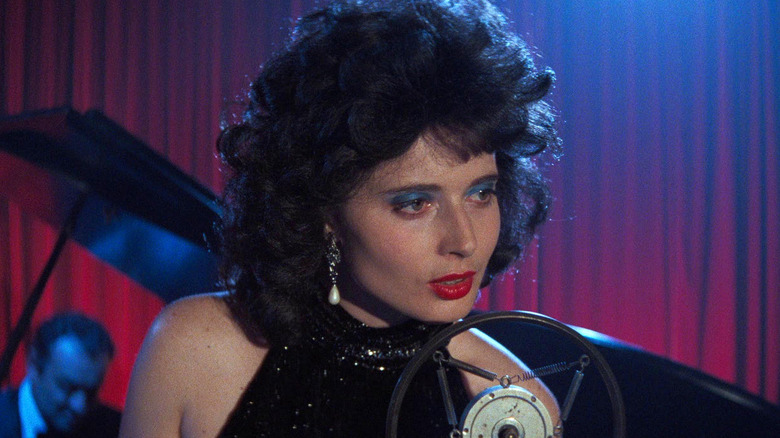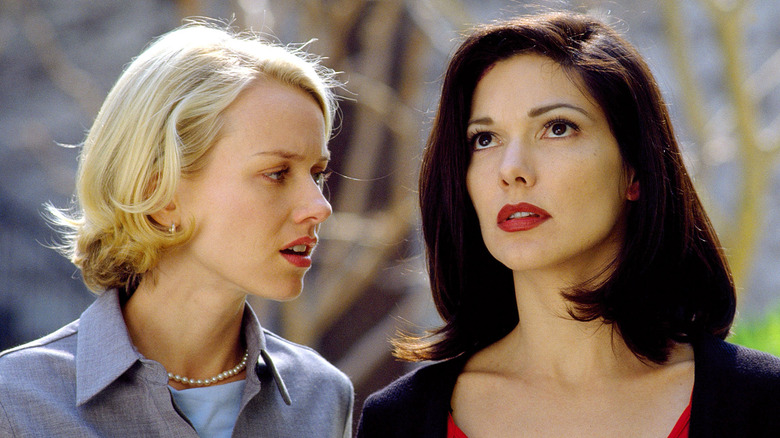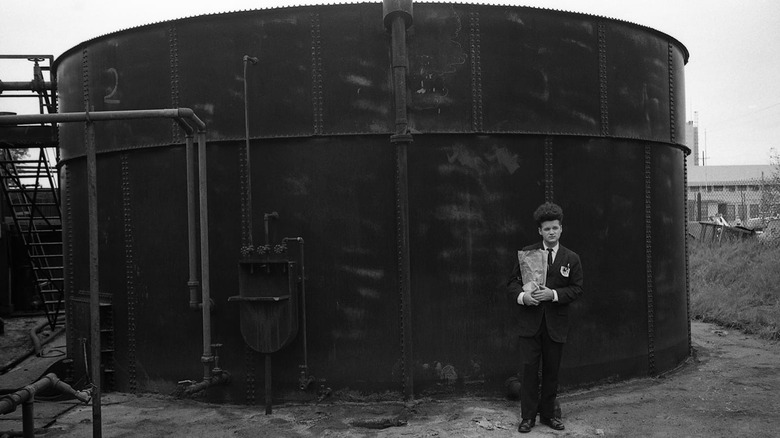Why You Can Never Tell Exactly What Era A David Lynch Film Takes Place In
Everybody loves a good period piece, from the modern classic "Once Upon A Time... In Hollywood," to the timeless throwback "Grease." We all share a deep nostalgia for bygone eras, and even avant-garde directors like David Lynch aren't immune to this wistful longing for the past. Rather than pay homage to specific eras in his films, Lynch takes a different approach.
In his 2007 David Lean BAFTA lecture, Lynch explained that he doesn't like to recreate reality in cinema. Instead, he sees filmmaking as a way to "create another world" that abides by its own logic. For him, this is "what's so beautiful about [cinema]" — the ability to create a new universe full of unique experiences. This is why many of his most beloved films have a non-era-specific feel. The director draws upon references from across the 20th century to make films that feel at once retro and entirely new. His films are just like everyday life in that we "relive the past" and "plan for the future" while "new things [are] coming up every second," as he explained to Criterion.
As a result, films like "Blue Velvet," "Eraserhead," and "Mulholland Drive" deliberately evoke era-specific feelings while remaining totally timeless.
The shiny exterior, and the darkness underneath
Lynch's controversial 1986 film "Blue Velvet" is a mind-bending mystery set in small-town-America. A college student named Beaumont (Kyle MacLachlan) helps a detective's daughter (Laura Dern) solve a local murder case. When investigating a seductive lounge singer (Isabella Rossellini), Beaumont gets wrapped up in the town's sinister and depraved underbelly, where he meets the horrifying maniac Frank Booth (Dennis Hopper).
"Everybody said [Blue Velvet] is like the 1950s," Lynch recalled during his BAFTA lecture, "the optimistic shiny exterior and then a lot of darkness swimming beneath it." The director conceded that "all those things go on" in the film that went on in the '50s. But they continue to go on now. "It doesn't matter what time it is," he explained.
When asked if the film was "timeless," the filmmaker responded, "sure." Lynch doesn't like to explain his films, but the cinematic language in his work suggests that the time period is purposefully vague. The hair, makeup, and wardrobe in "Blue Velvet" all reference the '80s, for example. But Frank Booth drives a '68 Dodge Charger and is obsessed with the 1963 Roy Orbison song "In Dreams." The film also takes its name from another '60s song — Bobby Vinton's "Blue Velvet."
The Hollywood dream is timeless
"Mulholland Drive" centers around a blonde aspiring actress (Naomi Watts) who helps an amnesiac brunette (Laura Harring) recover her identity after a devastating car wreck. Things take a turn when (spoilers) it is revealed that the first story was just a film within a film and that the women are actually being played by two actresses sharing a secret affair — one struggling to break into the industry, and the other an established star. It has the feel of both the golden age of early-to-mid-century Hollywood as well as the cultural vibrance of '90s L.A.
These references to the golden age in Lynch's work are intentional. Naomi Watts' character in the second half of "Mulholland Drive" is heavily inspired by Gloria Swanson in Billy Wilder's 1950 film "Sunset Boulevard," an aging silent film star that refuses to accept the decline of her career ... played by an aging silent film star that refuses to accept the decline of her career. Lynch told Criterion how in this meta respect, "'Sunset Boulevard' says so much about that Hollywood dream thing."
This portrait of a struggling actress was just as relevant to the Hollywood of 2001 as it was in 1950. Hollywood is "a party," and only a select few are invited. "You could call it fate," Lynch continued. "If it doesn't smile on you, there's nothing you can do. You can have the greatest talent and the greatest ideas, but if that door doesn't open, you're fresh out of luck. It takes so many ingredients and the door opening to finally make it."
Worlds outside of time
With his first feature, 1977's "Eraserhead," Lynch created a nightmarish world outside of time. The characters inhabit a dystopia of industrial waste and metallic screeches. One unsettling scene was shot in an old oil well that has since become the Beverly Center. Lynch described the well as being "like a set" for a film, a world all to itself. This made it a perfect fit for the uncanny world of this timeless horror film. Lynch loved that the oil well had the "feeling of a place back in time, because it hadn't changed."
The director has a strong nostalgia for the golden age of Hollywood and often seeks out locations that have survived from this era to shoot in. "There are still many places you could go in L.A. to catch the drift of the old golden age," the filmmaker told Criterion, "but they're getting fewer."
Still, Lynch doesn't aim for historical accuracy in his work. His films draw upon the past and the present to create a unique universe unlike anything seen before or again. To watch a Lynch film is like stepping into a vision of the past that is as unstable as a memory and as unpredictable as a dream, and I absolutely love it.



